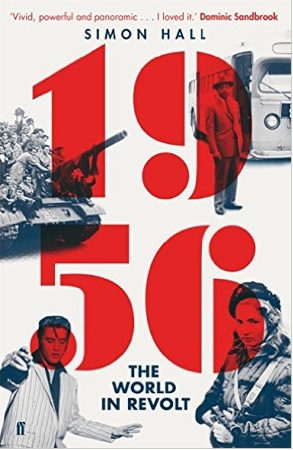1956: A Year that Changed America
In January 1960, Harper’s Magazine published an essay by the Bancroft-Prize-winning historian Eric Goldman entitled, “Good-Bye to the ’Fifties—and Good Riddance.” Goldman, a Princeton University professor and public intellectual, famously dismissed the decade as among “the dullest and dreariest in all our history,” arguing that growing prosperity and consumerism had sapped the American spirit—“we maunder along,” he complained, “in a stupor of fat.” Goldman’s entertaining broadside encapsulates the still-dominant view of the American 1950s as an era of bland, self-satisfied ‘consensus.’ And yet, alongside the identikit suburban developments, the television advertisements selling Madison Avenue’s version of the ‘good life,’ and the rise of the middlebrow, the 1950s was also a time of rising social tensions (particularly over race), artistic and cultural innovation—including the abstract expressionism of Jackson Pollock and the novels and poems of the Beats—and widespread anxieties about the Communist threat.
No year captures the contradictions of the decade more powerfully than 1956. This was the year when Dwight David Eisenhower, a moderate, middle of the road Republican who advocated leadership through “persuasion and conciliation and patience” and denounced the “technique of pitting group against group for cheap political advantage,” was re-elected to the White House in a landslide. It was the year in which Congress passed the National Interstate and Defense Highways Act, authorizing $32 billion for the construction of an interstate highway system that would spur the growth of suburbia and help make possible an array of new consumer pleasures, including the motel and the drive-in movie theater. And it was the year when, with the economy motoring along nicely, those in professional, managerial or administrative roles came to outnumber manual workers for the first time in the nation’s history, making the United States the world’s first ‘post-industrial’ society.
But 1956 was also the year that saw explosive clashes all across the South, between African Americans, who were determined to overthrow Jim Crow, and hardline white supremacists pledged to ‘massive resistance.’ In Montgomery, African Americans persisted with their boycott of the city’s segregated buses in the face of death threats, bombings, petty harassment, insults, economic coercion and mass arrests. At the University of Alabama, 26-year-old Autherine Lucy braved a vicious mob of white racists, who pelted her with eggs and rocks and chanted “kill her, seize her, burn her, lynch her,” to become the first African American to attend classes at the state’s flagship school. And that summer Governor Frank G. Clement dispatched a hundred jeeps, seven tanks, three armored personnel carriers, and 600 national guard troops to the little mill town of Clinton, Tennessee, to restore order—and ensure the peaceful integration of the local high school—after segregationist firebrands had whipped up a storm of racial hatred that threatened to rage out of control. These were the opening skirmishes of a totemic struggle that would transform Dixie, and the nation at large, over the course of the following decade.
1956 was also the year of Allen Ginsberg’s Howl, Elvis Presley’s Heartbreak Hotel, and the first rock ‘n’ roll riots. The year also saw the publication of The Power Elite, by C. Wright Mills, whose arguments about the interlocking interests of the military, corporate and political elites, and the relative powerlessness of ‘ordinary’ Americans in the face of such a powerful block, would prove hugely influential for a generation of radical activists and intellectuals. In March, the first issue of Liberation hit the newsstands. Founded by veteran pacifists A. J. Muste, David Dellinger, and Bayard Rustin, the magazine called for “fresh thinking” and “action now” to challenge conformity, abolish racism, and secure political, social and economic freedoms. Meanwhile, in October, the first issue of The Ladder (the official monthly magazine of the pioneering lesbian organization the Daughters of Bilitis) was hammered out on an old typewriter and mailed to just 200 people, mostly middle-class professionals, in the San Francisco Bay Area. The magazine, which would evolve into a sophisticated and well-respected publication, urged lesbians to cast aside fear and cowardice, and develop an “energized constructive program” that would thwart the “evils of ignorance, superstition, prejudice and bigotry.” Signs, then, of the social, political and cultural turbulence to come.
Finally, 1956 was a year of smoldering international tensions. When first the Poles, and then the Hungarians, rose up against their Soviet masters, they challenged the United States to make good on all its recent talk about “liberating” the “captive peoples of Eastern Europe” and rolling back the Iron Curtain. Meanwhile, the Anglo-French attempt to launch a war against Egypt behind Washington’s back, in an effort to seize back control of the Suez Canal, not only strained the Western Alliance to breaking point, but dragged the United States to the brink of a thermonuclear confrontation with the Soviet Union—with Moscow threatening to send the Red Army into the Middle East and the Sixth Fleet on full alert in the Mediterranean, Eisenhower considered the possibility that “if those fellows start something, we may have to hit them—and, if necessary, with everything in the bucket.” The dramatic denouement to 1956 would leave the Cold War in Europe in a semi-permanent stalemate (the superpower rivalry would soon shift to Southeast Asia, Africa, and Latin America) while, in the Middle East, the United States would move to displace Great Britain as the premier power in this volatile region, with consequences that continue to reverberate today.
Racial conflagrations, cultural rebellion, and geopolitical convulsions: 1956 was not just a year of extraordinary drama; it was a year that changed America.
